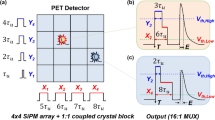Abstract
We have proposed an OpenPET geometry which consists of two axially separated detector rings. The open gap is suitable for in-beam PET. We have developed the small prototype of the OpenPET especially for a proof of concept of in-beam imaging. This paper presents an overview of the main features implemented in this prototype. We also evaluated the detector performance. This prototype was designed with 2 detector rings having 8 depth-of-interaction detectors. Each detector consisted of 784 Lu2xGd2(1-x)SiO5:Ce (LGSO) which were arranged in a 4-layer design, coupled to a position-sensitive photomultiplier tube (PS-PMT). The size of the LGSO array was smaller than the sensitive area of the PS-PMT, so that we could obtain sufficient LGSO identification. Peripheral LGSOs near the open gap directly detect the gamma rays on the side face in the OpenPET geometry. Output signals of two detectors stacked axially were projected onto one 2-dimensional position histogram for reduction of the scale of a coincidence processor. Front-end circuits were separated from the detector head by 1.2-m coaxial cables for the protection of electronic circuits from radiation damage. The detectors had sufficient crystal identification capability. Cross talk between the combined two detectors could be ignored. The timing and energy resolutions were 3.0 ns and 14%, respectively. The coincidence window was set 20 ns, because the timing histogram showed that not only the main peak, but also two small shifted peaks were caused by the coaxial cable. However, the detector offers the promise of sufficient performance, because random coincidences are at a nearly undetectable level for in-beam PET experiments.









Similar content being viewed by others
References
Yamaya T, Inaniwa T, Minohara S, Yoshida E, Inadama N, Nishikido F, et al. A proposal of an open PET geometry. Phys Med Biol. 2008;53:757–73.
Yamaya T, Inaniwa T, Yoshida E, Nishikido F, Shibuya K, Inadama N, et al. Simulation studies of a new ‘OpenPET’ geometry based on a quad unit of detector rings. Phys Med Biol. 2009;54:1223–33.
Yamaya T, Yoshida E, Inadama N, Nishikido F, Shibuya K, Higuchi M, et al. A multiplex “OpenPET” geometry to extend axial FOV without increasing the number of detectors. IEEE Trans Nucl Sci. 2009;56:2644–50.
Crespo P, Barthel T, Frais-Kolbl H, Griesmayer E, Heidel K, Parodi K, et al. Suppression of random coincidences during in-beam PET measurements at ion beam radiotherapy facilities. IEEE Trans Nucl Sci. 2005;52:980–7.
Nishio T, Ogino T, Nomura K, Uchida H. Dose-volume delivery guided proton therapy using beam on-line PET system. Med Phys. 2006;33:4190–7.
Miyaoka RS, Lewellen TK, Yu H, McDaniel DL. Design of a depth of interaction (DOI) PET detector module. IEEE Trans Nucl Sci. 1998;45:1069–73.
Seidel J, Vaquero JJ, Green MV. Resolution uniformity and sensitivity of the NIH ATLAS small animal PET scanner: comparison to simulated LSO scanners without depth-of-interaction capability. IEEE Trans Nucl Sci. 2003;50:1347–50.
Ziemons K, Auffray E, Barbier R, Brandenburg G, Bruyndonckx P, Choi Y, et al. The ClearPET™ project: development of a 2nd generation high-performance small animal PET scanner. Nucl Instr Meth A. 2005;537:307–11.
McElroy DP, Pimpl W, Pichler BJ, Rafecas M, Schüler T, Ziegler SI. Characterization and readout of MADPET-II detector modules: validation of a unique design concept for high resolution small animal PET. IEEE Trans Nucl Sci. 2005;52:199–204.
Tsuda T, Murayama H, Kitamura K, Inadama N, Yamaya T, Yoshida E, et al. Performance evaluation of a subset of a four-layer LSO detector for a small animal DOI PET scanner: jPET-RD. IEEE Trans Nucl Sci. 2006;53:35–9.
Parodi K, Crespo P, Eickhoff H, Haberer T, Pawelke J, Schardt D, et al. Random coincidences during in-beam PET measurements at microbunched therapeutic ion beams. Nucl Instr Meth A. 2005;545:446–58.
Tomitani T, Pawelke J, Kanazawa M, Yoshikawa K, Yoshida K, Sato M, et al. Washout studies of 11C in rabbit thigh muscle implanted by secondary beams of HIMAC. Phys Med Biol. 2003;48:875–89.
Yamaya T, Yoshida E, Inaniwa T, Sato S, Nakajima Y, Wakizaka H, et al. Development of a small prototype for a proof-of-concept of OpenPET imaging. Phys Med Biol. 2011;56:1123–37.
Kanazawa M, Kitagawa A, Kouda S, Nishioe T, Torikoshia M, Noda K, et al. Application of an RI-beam for cancer therapy: in vivo verification of the ion-beam range by means of positron imaging. Nucl Phys A. 2002;701:244–52.
Mashino H, Yamamoto S. Development of a compact and flexible data acquisition system for K-PETs. World Congress on Medical Physics and Biomedical Engineering 2006 IFMBE Proceedings. 2007;14:1722–25.
Yoshida E, Kitamura K, Tsuda T, Shibuya K, Yamaya T, Inadama N, et al. Energy spectra analysis of four-layer DOI detector for brain PET scanner: jPET-D4. Nucl Instr Meth A. 2006;557:664–9.
Nishikido F, Yazaki Y, Osada H, Inadama N, Inaniwa T, Satoh S, et al. Influence of secondary particles from heavy ion irradiation to in-beam OpenPET detectors. 2009 IEEE NSS & MIC Conf. Rec. 2009;J04–5.
Yamamoto S, Horii H, Hurutani M, Matsumoto K, Senda M. Investigation of single, random, and true counts from natural radioactivity in LSO-based clinical PET. Ann Nucl Med. 2005;19:109–14.
Goertzen AL, Suk JY, Thompson CJ. Imaging of weak-source distributions in LSO-based small-animal PET scanners. J Nucl Med. 2007;48:1692–8.
Acknowledgments
We wish to thank Drs. T. Fujibayashi and I. Kanno of NIRS for their encouragement. We wish to thank Mr. H. Mashino for his technical support.
Author information
Authors and Affiliations
Corresponding author
About this article
Cite this article
Yoshida, E., Kinouchi, S., Tashima, H. et al. System design of a small OpenPET prototype with 4-layer DOI detectors. Radiol Phys Technol 5, 92–97 (2012). https://doi.org/10.1007/s12194-011-0142-1
Received:
Revised:
Accepted:
Published:
Issue Date:
DOI: https://doi.org/10.1007/s12194-011-0142-1




